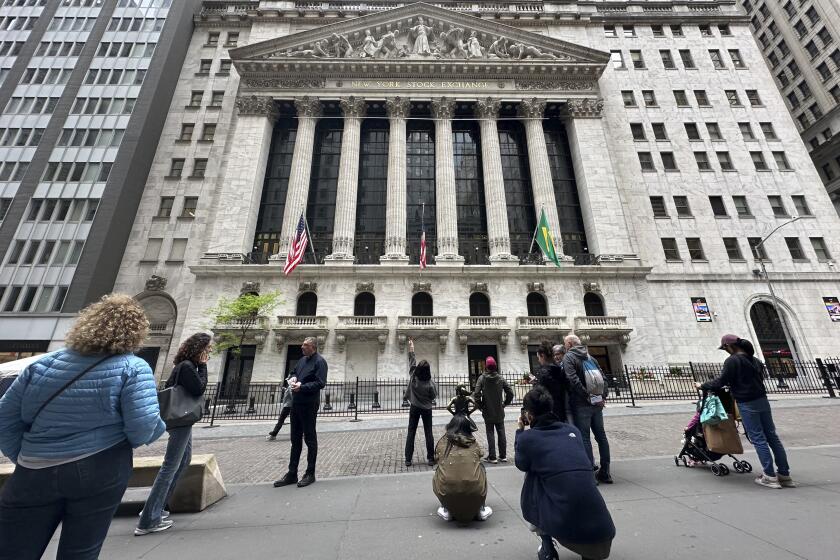Manufacturing Forecast Looks Hazy in California
Irv Becker, chief of purchasing for an aluminum recycling plant in Fontana, has a few choice words on the state of manufacturing in California.
“Things look dark,” he said, grumbling that when autos don’t sell, his product piles up in the yard. “People are not buying things, that’s the problem.”
But down the road in Beaumont, Steven Morgan, president of Precision Stamping Inc., which makes dies for the electronics industry, is starting to see orders pick up. “I’m a lot happier now than I was a year ago,” said Morgan, who recently laid off one-fourth of his workforce but sees the picture brightening in the coming months.
Their divergent views underscore the muddled outlook for the state’s manufacturing industry.
Battered by recession, foreign imports, and spiking energy and workers’ compensation costs, the sector has been bleeding jobs for more than two years. State figures released Friday show that California factories shed 6,500 jobs in July, and economists expect such losses to continue for at least the near term.
But there are also signs that manufacturing nationally may be turning around. Industrial production has been rising in recent months, and the latest survey of purchasing managers found a better-than-expected 1.7% increase in factory orders in July. Some manufacturers, such as makers of industrial machinery, are benefiting from the weaker dollar, which has brought higher revenue for sales overseas. And with the increase in defense spending, many companies that supply the military are seeing strong sales growth.
Even so, economists say the picture of manufacturing in California still looks blurry.
“There’s no consistent pattern,” said Barbara Sirotnik, an economist with the San Bernardino Institute of Applied Research, which surveys manufacturers monthly in the Inland Empire. “To establish a trend you need three consecutive months moving in the same direction, but the indicator keeps bouncing around.”
Since late 2002, Sirotnik said, manufacturing in the Inland Empire has been in a holding pattern, with the purchasing managers’ index bouncing between the high 40s and low 50s. A number below 50 indicates a shrinking manufacturing sector, while one higher than 50 indicates growth. The figure for July was 48.4, down from 49.8 in June.
The comparable reading for U.S. manufacturing in July was 51.8, up from 49.8 in June.
A similar statewide index, which looks at such factors as orders, production and employment, is issued quarterly by Chapman University in Orange. That figure stood at 47.5 for the second quarter, slightly below the national index for a comparable period and a two-point drop from the previous quarter.
Survey director Raymond Sfeir, a professor of economics at Chapman, expects to see a change for the better soon. “We think the second half of the year will be closer to 50,” he said. “That means we will no longer be in decline, but we’re not expecting any high growth for a while.”
Sfeir noted that the state’s dismal high-tech sector, concentrated in the Bay Area, has dragged down overall manufacturing figures and kept California from matching the rest of the country. Outside high-tech, California’s manufacturing of durable goods -- items meant to last three years or longer -- showed stability in the second quarter, with a rating of 50.3. For the same period, the high-tech sector stood at 43.4.
The lack of definitive movement has manufacturers reluctant to add to their payrolls or invest in new equipment.
“The uncertainty is coming through loud and clear,” said economist Shel Bockman, co-director of the Inland Empire survey. “It’s almost existential. You’ve got all these wild cards in the back of your mind, which makes it impossible to plan. One thing an economy needs is predictability, and we don’t have it.”
California remains a hotbed for manufacturing, with major centers in computer equipment, garment and textiles, furniture, aerospace parts and food manufacturing. But since the economic downturn began in late 2000, more than 300,000 of the state’s factory workers have received pink slips, representing an 18% cut in those jobs.
Nationally, the sector hasn’t fared much better, with at least 15% of manufacturing jobs vanishing in the same time frame, according to former state economist Ted Gibson.
Even if orders pick up immediately in California, the job cuts are likely to continue through the year. Workers’ compensation costs, which more than doubled for many employers during the last year, is a major culprit. With costs per employee so high, employers are unlikely to increase payrolls until absolutely necessary.
“They are trying to squeeze as much as possible from their workers, and I believe they will continue to do that for the next six months,” said Sfeir, the Chapman professor. “We may see orders picking up, and production not declining, but they are going to keep squeezing as much as they can out of the employees they have now.”
In fact, high insurance costs are driving manufacturers in California to consider relocating to neighboring states.
Among them is John Lawrence, who runs a 200-employee firm in South El Monte producing tortilla-making machines. He said his business has been growing steadily, but higher costs are eating away at profit.
“We could save $300,000 a year in Arizona, $363,000 if we go to Nevada,” he said of workers’ comp costs.
“It’s not just us,” said Lawrence, the president of Lawrence Equipment. “Look around South El Monte. It used to be all small manufacturing around here. Now what have we got? Distributors selling tennis shoes from China.”
In Beaumont, Steven Morgan is holding firm -- and looking for an upswing.
In the last few weeks, he said, requests for quotes for his products have shot up. Although it could take six months or longer for those to turn into actual orders, Morgan sees that as a promising sign not only for his company but others in the manufacturing sector.
Morgan makes tools used to make other products, and as such, his company is “at the beginning of the food chain” in the production cycle. Increased calls for quotes could indicate that other manufacturers are gearing up for growth. “That’s telling me the economy is turning,” he said.
However, Becker, who sells recycled aluminum mainly to the automotive trade, said his phone hasn’t been ringing lately.
Competition from Asia and a drop in auto sales are both hurting his company, TST Inc. With 350 employees, Becker is running his operation at 60% and still piling up excess inventory.
“We have not run at capacity all year,” he said. “And we don’t really see much improvement on the horizon.”






